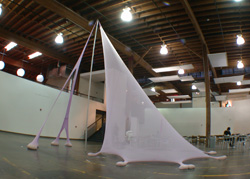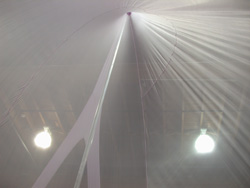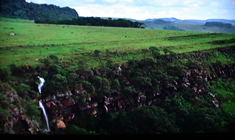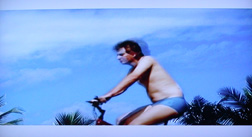
|
||
|
Portland art blog + news + exhibition reviews + galleries + contemporary northwest art
|
||
Troca Brasil at Feldman Gallery
Walking into Troca Brasil, one might expect to uncover a set of cultural cliches - lurid color, sensual forms, exotic content. Each of the five artists in the show is connected in varying degrees to A Gentil Cariocia, a Rio de Janeiro gallery whose name makes reference to the city's inhabitants as well as the traditions that permeate Brazilian culture. Upon entering PNCA's Feldman Gallery, however, one is greeted by a spacious and sparsely installed exhibition that doesn't exactly engulf visitors with sensuality or exoticism. Portland's press have discussed the show primarily in terms of its sensual qualities, but, while there is plenty to be found, Troca Brasil is successful for its resistence to the cultural and artistic cliches of sensuousness. The artists of Troca Brasil balance a regard for sensory experience with formalism and ideas that elicit much more than just a gut-level emotional response. The occupants of Laura Lima's chicken coop are decked out with brightly dyed feathers, typically used for carnaval, ridiculously fastened atop their own plumage. It creates a convivial atmosphere within the gallery (and during lectures in adjacent commons when intermittent cawing is heard in the background), but it's also a continuation of Lima's ongoing work exploring the ways that ritual and costume interact. Earlier work includes a gallery performance recreating a 16th century painting of a formal ball, complete with period costumes, as well as more contemporary costumes that oftentimes restrict the wearer in some way. Her Doped Woman performance at ARCO 2000 consisted of a woman cocooned in a long knit costume that was directly attached to the wall. Pieces from her Man=Flesh/Woman=Flesh series, explores the relationship of two humans constrained by a shared costume. One photographic documentation shows two nude men locked in a fighting embrace, heads completely obscured by a shared and blinding hood (find pictures at Casa Triangular's website). Lima's Gala Chickens is not the first piece she has created exploring the concept of costumes through the animal world. During "A Little Bit of History Repeated," curator Jens Hoffmann's two day survey of noted performance art pieces as translated by younger contemporary artists, Lima's homage to Yoko Ono's Cut Piece replaced the performer with a goat. Ernesto Neto's My Little Castle...Blue (two times for infinity), a womb-like nylon structure grounded by testicular sacs of rice and sand, invite associations with the sensual and sexual terrain of the body. But just as important is the gravity-defying construction of the piece, whose lycra walls stretch nearly two stories high, with only a single, freestanding aluminum rod for support. During Neto's lecture in early September, in which he revealed an effusive charm and knack for storytelling, the artist repeatedly referred to both the role of sensuality and to his ongoing engagement with formalism that has allowed for his work to develop. The interplay between brute physicality and soft gestural forms are very apparent in his sculpture at PNCA. At one point in the lecture, Neto recounted an early experiment that initiated a new way for him to think about sculpture. One day, while alone in his family's apartment, he became irritated by his dog's toy ball, which he found constantly underfoot. In a spontaneous act, Neto propped the ball high against the wall using a stick. Neto realized that he had found a way to use gravity and force as an integral part of this newly discovered sculptural form. This early piece shares a kind of formal engagement with physicality not unlike Serra's Corner Prop. But Neto reformulates some of these key sculptural principles in a very gestural, fluid manner. Soon after this discovery, Neto turned to women's stockings as a source material, allowing for an even greater use of gesture and visible tension; translucent lycra remains one of his primary sculptural materials.
My Little Castle is unlike many of Neto's other works in that it doesn't attempt to fill the room. Situated in the large Swigert Commons at PNCA, the piece is dwarfed in scale. Neto confessed in his lecture that he is challenged in creating smaller, simplified pieces, since he naturally tends to create larger, more complex works. My Little Castle is one such attempt to create a smaller scale work that retains the essential formal aspects that make his work so successful. Having experienced several of his room-sized installations in larger exhibitions, I found that the current installation didn't have as much immediate impact, since its relative scale made it appear as a self-contained sculpture rather than an environment, but was more successful in laying bare the mechanisms of its construction. Revisiting the piece several times throughout the run of the exhibition, I found myself increasingly intrigued by the deceptive airiness of the sculpture combined with the display of brute force working to keep the structure standing. Neto also presented a delicate wall drawing, a bean-like shape with soft ridges that reminded me of Arp's geometric sensibilities, created from a pattern of what appear to be large thumb-prints or circular stamps. Like Neto's signature sculptures, it makes use of soft edges and creates a sense of translucence that is analogous to his use of transparent fabrics.
Thiago Rocha Pitta's video, Double Fountain, explores compositional formality by juxtaposing natural phenomena with artificially created scenarios. The film shows a waterfall cascading from a lush hillside. Smoke or steam begins to rise from somewhere near the hidden source of the waterfall, simulating a mirror image of the waterfall that is diffuse and rises into the air rather than falls by force of gravity to the ground, eventually dispersing entirely into the surrounding atmosphere. Massares also creates situations that act within the surrounding environment, but most often creates social interventions within urban rather than natural environments. His ply-wood construction serves as an amplifier for deep bass sounds that are emitted at random. Those who happen to be standing nearby feel the sound as much as hear the sound, creating a very strong, reflexive response.
Certain aspects of videos by Marcio Botner, working in collaboration with Pedro Agilson, remind me of early video by artists like Bruce Nauman, most notably for his use of artist as performer and a focus on the body. I will only discuss two out of three videos on display in this review, since the White Over White video was out of commission on multiple visits to the gallery. In both Lanscape and A Thousand Words, the artist is used as the sole performer in front of the camera and a kind of goofiness permeates the representation of the artist's body and movements. Although the work is created using computer technology, Bottner intentionally employs crude techniques to animate his films, sequencing hundreds of still frames that result in jerky, stylized movement. Lanscape is an exploration of the imaginary terrain. The video begins with a scene showing a black and white image of the artist, wearing nothing more than a Speedo, on an exercise bike, positioned squarely in front of a small screen playing an inspirational full-color video of himself riding a functional bicycle along an ocean side path. The video then morphs into a segment showing only the outdoor bicycle ride. The artist's head, shown in profile, moves comically back and forth from exertion, the still frame animation adding an even more stylized aspect to the movement, which is not unlike Lima's chickens across the gallery. Near the end of the video, the rider fades away and the bicycle ascends into the clouds, pedals still spinning. The scene then returns to the exercise room, the exercise bike emptily spinning in communion with its functional counterpart still displayed on screen. We are reminded of the intangibility of virtual worlds and perhaps the video also acts as a parody of transcendent states as experienced through punishing physical exertion. A Thousand Words, is a clever take on the aphorism, and a jab at criticism and institutionalization. A series of (presumably one thousand) words scrolls continuously across the bottom of the screen. The words are all derived from the canon of art history and criticism, and include everything from descriptive adjectives (softness, illuminosity) to art movements (body art, art brut, futurism) and terms that allude to the careerist aspects of art (art graduation). The actor sits bare-chested behind a table, eyes staring straight ahead, flipping through what appears to be an old art history textbook of sorts. The artist appears to be reading the terms scrolling across the bottom, pausing only to use a flyswatter sitting at his right elbow to obliterate the word "masterpiece" and later, the word "copy." Once again, stop motion animation lends a strong stylization to the piece and Botner's facial expressions are comically monkey-like. Perhaps Botner is irreverently suggesting that it's all just simply chatter. Troca Brasil is on view until the end of this week. Through October 22 Posted by Katherine Bovee on October 18, 2005 at 12:37 | Comments (0) Comments Post a comment Thanks for signing in, . Now you can comment. (sign out)
(If you haven't left a comment here before, you may need to be approved by
the site owner before your comment will appear. Until then, it won't appear
on the entry. Thanks for waiting.)
|
| s p o n s o r s |
 |
 |
 |
 |
 |
 |
 |
 |
 |
 |
 |
 |
 |
 |
 |
 |
 |
 |

|
Site Design: Jennifer Armbrust | • | Site Development: Philippe Blanc & Katherine Bovee | |





